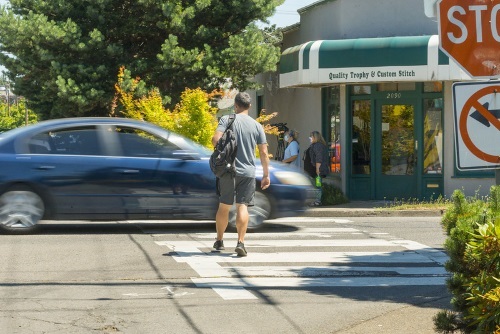The U.S. Department of Transportation established October as the first-ever National Pedestrian Safety Month and, concurrently, many state departments of transportation are highlighting their efforts to improve pedestrian safety.
[Photo courtesy of the Oregon DOT.]
For example, the California Department of Transportation is enhancing pedestrian safety measures at high-risk locations based on traffic collision data, using what it calls a “first-of-its-kind” pedestrian safety toolbox that includes 47 countermeasures. Those include:
- Signal timing enhancement and extended pedestrian crossing times.
- Intersection and roadway design changes, such as adding sidewalks, curb extensions, and roundabouts or raised intersections that provide enhanced pedestrian safety in high traffic locations.
- New pedestrian signs and markings, including high-visibility crosswalks, advanced stop and yield markings, or “yield to pedestrian” signs.
- Caltrans is already implementing those safety measures and expects to identify further safety improvements by September 2021.
The agency noted that in California, pedestrians are 37 times more likely to be injured in a collision than any other roadway user. On top of that, between 2008 and 2017, the department said pedestrian-related incidents accounted for 19 percent of all collisions resulting in death or serious injury.
“At least two pedestrians or cyclists lose their lives on California’s transportation system each day — a number we refuse to accept or normalize,” stressed Toks Omishakin, director of Caltrans, in a statement. “Safety remains our top priority and the department will work diligently until the trend is reversed.”

Photo courtesy of Caltrans
In addition, the California Transportation Commission recently approved $100 million for projects that promote active transportation options, including the addition of 310 miles of new and repaired bike lanes; installing and repairing nearly 50 miles of sidewalk; installing nearly 3,000 new crosswalks; making 178 transit stop improvements, such as installing and improving bus shelters.
The California Office of Traffic Safety (OTS) is also providing more than $8 million in funding for programs dedicated to the safe and equal access to roads for pedestrians, including:
- Complete Streets Safety Assessments to assist local agencies statewide in identifying and implementing infrastructure improvements to pedestrian safety and accessibility.
- Community Pedestrian and Bicycle Safety Training programs that encourage local residents in underserved communities to develop a community action plan to improve walking and biking safety.
- Coordinate Walking Tours and education outreach with health care providers and senior centers. Focus on high-collision areas for older adult pedestrians and measures to improve safe travel for older adults.
- Develop “walking school buses” with groups that walk with students to school and educate students on traffic rules and best safety practices.
“Behavior change goes hand-in-hand with infrastructure improvements,” noted Barbara Rooney, director of OTS. “Safe habits by drivers and pedestrians complement a transportation system that is designed with pedestrian travel in mind.”
Meanwhile, the Utah Department of Transportation and Zero Fatalities donated 3,500 reflective drawstring backpacks to homeless service providers throughout Salt Lake County to help those experiencing homelessness stay visible to drivers during the fall, which is typically the most dangerous time of year for pedestrians.
The North Carolina Department of Transportation kicked off its 2020 Watch for Me NC awareness campaign in late September with a new twist: distributing safety tips in English and Spanish for motorists, bicyclists, and pedestrians within food delivery orders.
At the same time, North Carolina law enforcement officers are getting special training for enforcing bicycle and pedestrian safety laws as part of the program, which officially launched in 2012 to promote pedestrian safety. There are now 30 participating partner communities across the state, the North Carolina DOT said.
“It’s great to be partnering with so many communities to proactively deliver safety messages to help raise awareness and reduce fatalities among pedestrians and bicyclists in our state,” explained Heather Hildebrandt, interim director of the department’s Integrated Mobility Division, in a statement.
The Oregon Department of Transportation is using the focus on pedestrian safety to bring attention to “White Cane Safety Day,” which falls on October 15. Established by Congress in 1964, “White Can Safety Day” aims to be “a day of awareness, education, and celebration of white canes and guide dogs for independent and safe travel” for blind pedestrians.
The Oregon DOT noted in a statement that crashes between pedestrians and motor vehicles are far more likely to take place at night when it is often harder to see people walking. Between 2015 and 2017, 77 percent of such fatal crashes occurred at night. The agency added that the number of crashes involving pedestrians in Oregon increased from 849 in 2013 to 984 in 2018, the year for which the latest such data available. Concurrently, the number of pedestrians killed in a motor vehicle crash has increased from 52 in 2013 to 79 in 2018. The top driver error involved in those crashes? Failing to yield right of way to a pedestrian, the Oregon DOT said.

